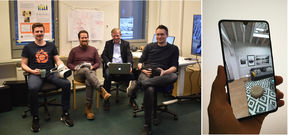Researchers developed a new solution that brings high quality extended reality to easy-to-use and inexpensive devices

Augmented reality (AR), virtual reality (VR), and mixed reality (MR) technology open new possibilities in several different fields. However, high quality extended reality (XR) applications are computationally heavy in terms of computer graphics, which means that they do not run smoothly on inexpensive and easy-to-use XR devices, such as VR/AR headsets and smart phones, because their GPU computing capacity is limited.
Matti Siekkinen, Teemu Kämäräinen, Olavi Mertanen, and Thomas van Gemert, researchers at Aalto University Department of Computer Science, have developed technology that solves this problem. The solution makes use of distributed computing and offloads the heaviest part of graphics rendering to remote servers.
According to the project’s Principal Investigator Matti Siekkinen, this type of new technology can benefit experts in education, interactive media or healthcare, among other fields. ‘However, the biggest benefits will be achieved in cases in which ease of use and high visual quality of the XR experience are both very important,’ Siekkinen explains.
When a part of the computing takes place on remote servers, the XR experience will be of higher quality. However, the use of distributed computing does not come without challenges of its own. Latency, in particular, is such a challenge, and in their solution, the Aalto researchers trust in latency-compensation. ‘In addition to distributed computing, we have developed an adaptive solution for latency-compensation, which provides a good user experience even when using a 4G network,’ continues Siekkinen.
In the 5G networks that are becoming increasingly common, network latency is low, bandwidth is high, and edge computing enables computing at close proximity to the user. All this makes it easier to use the new solution in increasingly complex situations that include a lot of interaction.Furthermore, the need for latency-compensation is reduced when using a 5G network.
Siekkinen says that during their research project they have tested the new solution with several collaborators. One of those collaborators is Elisa, a Finnish company offering telecommunications services, which on Thursday March 5 announced a demo application developed during the collaboration.
One aim of the Aalto computer scientists is to try to find the customers who will gain most benefit from the solution. ‘Our goal is to start a company that brings the solution to the market.’ says Olavi Mertanen.
The CloudXR project in question is a TUTLI (From Research to Business) project funded by Business Finland and Aalto University, which started at the beginning of 2019 and will end at the end of March 2020. The team has focused on exploring potential commercialization paths for XR applications’ remote rendering and developing the technology further.
Further information
- Published:
- Updated:
Read more news

DeployAI Partners Gather for Heart Beat Meeting in Helsinki
The European DeployAI project's partners gathered for the Heart Beat meeting hosted by Aalto University Executive Education in Helsinki.
Get to know us: Associate Professor Maria Sammalkorpi
Sammalkorpi received her doctorate from Helsinki University of Technology 2004. After her defence, she has worked as a researcher at the Universities of Princeton, Yale and Aalto.
Aalto computer scientists in ICML 2024
Computer scientists in ICML 2024